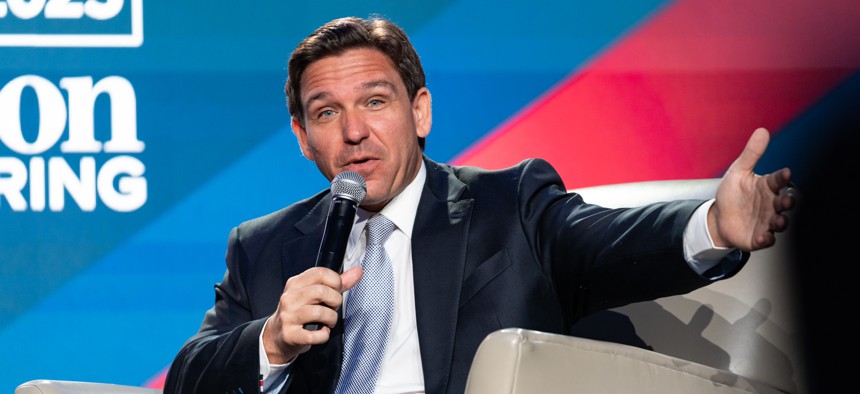Politics
You’ve got (a lot of) mail: Ron DeSantis’ campaign sends more email than GOP primary opponents
Most of his emails use “CRT,” “DEI,” and other culture war messaging.

Republican U.S. presidential candidate and Florida Gov. Ron DeSantis speaks at an event hosted by conservative radio host Erick Erickson on Aug. 18, 2023 in Atlanta, Georgia. The first debate of the Republican presidential primary is set to take place Aug. 23. Photo by Megan Varner/Getty Images
While Gov. Ron DeSantis might not be leading in the opinion polls for the Republican presidential nomination, he is beating the field when it comes to pushing ‘send.’
DeSantis’ campaign is sending out more daily emails seeking contributions and delivering his campaign’s message than any other primary candidate. His team is sending out about 3.5 emails a day, almost a full email more than the second place finisher, South Carolina U.S. Sen. Tim Scott.
Florida’s governor has had no problem courting big contributions from wealthy donors, but has struggled to bring in the level of small-donor support, such as donations under $200, that frontrunner Donald Trump has historically amassed.
Email marketing campaigns help drive a campaign’s success with those small donations, because it allows them to reach hundreds of thousands of people instantly and target those attempts to data they have collected about the person behind each email address.
To be sure, the political email industry as a whole has gotten flak due to no restrictions on the amount of email they can send. Also, email-list selling practices have resulted in many people, much to their dismay, receiving dozens of daily fundraising emails from candidates and interest groups. A request for comment is pending with DeSantis’ campaign about its email strategy.
That environment is what’s putting the DeSantis campaign into email overdrive, said Spiro Kiousis, executive associate dean at the University of Florida’s College of Journalism and Communications.
He said they are sending out so many just to break through the noise in people’s inboxes. And with his current war chest, DeSantis has the money to out-send his opponents by developing the staff and using digital ads to acquire email addresses at a quick rate. “The high frequency there is them trying to break through the clutter,” Kiousis said.
But campaign finance data suggests DeSantis’ email marketing campaign hasn’t been bringing home the bacon as one would expect from an operation of that size. He has raised about $2.8 million from donations under $200, a figure much smaller than the historic trends of Trump’s small-dollar performance.
Josh Klemons, a Democratic digital consultant that has followed and written about the email products of the major 2024 Republican presidential primary candidates, said DeSantis’ email frequency is likely in order to boost his standing with small-money donors.
Klemons cautioned, however, that hitting followers with frequent asks could exacerbate his problems. “DeSantis has a small-dollar donor problem. And he is trying to solve it with more emails, which is usually not the solution to that problem,” Klemons said.
Here’s why: “Turning off your list with an egregious amount of emails is not a good way to get them to open their credit card.”
Aubrey Jewett, assistant director of the School of Politics, Security and International Affairs at the University of Central Florida in Orlando, also is skeptical that the email deluge will right DeSantis’ woes.
He believes the campaign is trying to emulate what Trump did successfully in 2016 and 2020, but such tactics bring fewer returns because of email filtering and the switch to text messaging and more social media spending.
For instance, “even as someone that follows politics, 90% of the political emails I get are picked up by my spam filter. If you send out three, four or five emails a day with similar recurring content, I'm not sure that will work well because of spam filtering,” Jewett said.
DeSantis’ emails split between gift deals, culture war messages
The content of the campaign’s email onslaught has stayed on brand with his focus over the past few months: the culture wars.
According to an analysis Klemons conducted on the first 169 emails the DeSantis campaign sent out, 166 included the words “woke” and “DEI” and 161 used the acronym “CRT.” Those terms, referring to “diversity, equity and inclusion” and “critical race theory,” used frequently by DeSantis since his rise to national prominence and the target of legislation he has backed in Florida.
They are included in almost every email, even for campaign-branded products like bumper stickers, cups, and hats, ones that make up about half of those sent. The emails each include a 900-word biographical footer about the governor that highlights his victories in Florida.
To Kiousis, DeSantis playing his greatest hits in his emails is to be expected as it fits the purpose of email messaging. “Email messages, unlike other types of campaign messages, are really about reinforcing opinions, and crystallizing the opinions and perspectives of donors and voters that already support you,” he said.
Klemons said relying on a “woke” reference in every email suggests that the team is engaging in general messaging for now instead of segmenting the list to specifically target the interests of those on it. Instead, he believes DeSantis is hitting those on his email list with the same language.
“He's got a wide subsection of people on his email list, and he is talking to them all as if they are avid Newsmax viewers. I think that's a huge mistake,” he said.
But the themes aren’t the only thing repeating across emails. City & State’s analysis found that several of the DeSantis campaign’s product-related emails are reused word-for-word with a new heading several times, sent about a week apart from each other for four weeks straight.
Including a 900-word footer in each email and copying full emails wholecloth several times isn’t best practice in political email campaigns, Klemons said.
"I have never seen a campaign, at this kind of level, do something like that. It is not a normal thing for a campaign to do," he said.
“We’re seeing so many emails because they're not happy with the results of the emails that they're sending,” he added, “and if they are copy-pasting the same stuff over several days, you can see why.”
Contact Tristan Wood at twood@cityandstatefl.com and follow him on Twitter: @TristanDWood.
NEXT STORY: Miami faces another lawsuit over city commission redistricting — depending on Supreme Court decision
